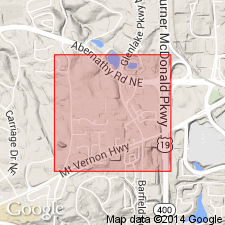
- Usage in publication:
-
- Manchester formation
- Modifications:
-
- Named
- Dominant lithology:
-
- Schist
- Gneiss
- AAPG geologic province:
-
- Piedmont-Blue Ridge province
Summary:
Manchester formation made up mainly of mica schist and garnet-biotite gneiss. Includes quartzite member, 50 to 300 feet thick, about 850 feet above base. Overlies the Hollis quartzite and is part of the Pine Mountain series. Age is Precambrian.
Source: GNU records (USGS DDS-6; Reston GNULEX).

- Usage in publication:
-
- Manchester schist*
- Modifications:
-
- Overview
- Dominant lithology:
-
- Schist
- Gneiss
- AAPG geologic province:
-
- Piedmont-Blue Ridge province
Summary:
Manchester schist is composed of mica schist and biotite gneiss. In vicinity of Warm Springs, contains enough graphite to mark paper. About 850 ft above base, contains persistent bed of quartzite that ranges from 5- to 300 ft in thickness. Overlies Hollis quartzite.
Source: GNU records (USGS DDS-6; Reston GNULEX).

- Usage in publication:
-
- Manchester formation
- Modifications:
-
- Revised
- AAPG geologic province:
-
- Piedmont-Blue Ridge province
Summary:
In Thomaston quad, referred to as formation in Pine Mountain group. Consists of three unnamed members (ascending): kyanite-muscovite schist and biotite schist--1200 to 3000 ft; quartzite--200 to 800 ft; and mica schist and feldspathic mica schist--1500 ft. Intruded by Jeff Davis granite (new). Age is Precambrian(?).
Source: GNU records (USGS DDS-6; Reston GNULEX).

- Usage in publication:
-
- Manchester Schist
- Modifications:
-
- Areal extent
- Overview
- AAPG geologic province:
-
- Piedmont-Blue Ridge province
Summary:
Uppermost unit of the Pine Mountain Group is the Manchester Schist. In AL, the Manchester is deeply weathered and poorly exposed. Where saprolite retains some of the original rock fabric, the Manchester appears to be intensely sheared yielding mylonite schist or button schist. Quartzite member is somewhat better preserved and stands above the surrounding rock. Principal area of outcrop is along the northern edge of the Towaliga fault zone.
Source: GNU records (USGS DDS-6; Reston GNULEX).

- Usage in publication:
-
- Manchester Schist*
- Modifications:
-
- Revised
- AAPG geologic province:
-
- Piedmont-Blue Ridge province
Summary:
The Manchester Schist is assigned to the Pine Mountain Group in the Pine Mountain anticlinorium in the Bill Arp thrust sheet in northern GA. The Manchester, as originally defined, is shown to be composed of two mappable units. The name Manchester Schist is retained for the lower unit of graphitic and sillimanitic schists, with thin graywacke beds near its top; the upper unit is named the Mountain Creek Formation. The Manchester is the depositional equivalent of the Kalves Creek Formation of the Great Smoky Group. Overlies the Hollis Quartzite of the Pine Mountain Group. Age is Late Proterozoic.
Source: GNU records (USGS DDS-6; Reston GNULEX).

- Usage in publication:
-
- Manchester Schist*
- Modifications:
-
- Overview
- Age modified
- AAPG geologic province:
-
- Piedmont-Blue Ridge province
Summary:
In the Pine Mountain belt (Pine Mountain window), Middle Proterozoic basement rocks are represented by Wacoochee Complex and its components, Whatley Mill Gneiss and Halawaka Schist. Overlying early Paleozoic cover sequence is represented by Pine Mountain Group, which consists of (ascending) Hollis Quartzite, Manchester Schist, and Chewacla Marble (Bentley and Neathery, 1970; Sears and others, 1981; and Crickmay, 1952). Report includes geologic sketch map.
Source: GNU records (USGS DDS-6; Reston GNULEX).
For more information, please contact Nancy Stamm, Geologic Names Committee Secretary.
Asterisk (*) indicates published by U.S. Geological Survey authors.
"No current usage" (†) implies that a name has been abandoned or has fallen into disuse. Former usage and, if known, replacement name given in parentheses ( ).
Slash (/) indicates name conflicts with nomenclatural guidelines (CSN, 1933; ACSN, 1961, 1970; NACSN, 1983, 2005, 2021). May be explained within brackets ([ ]).

